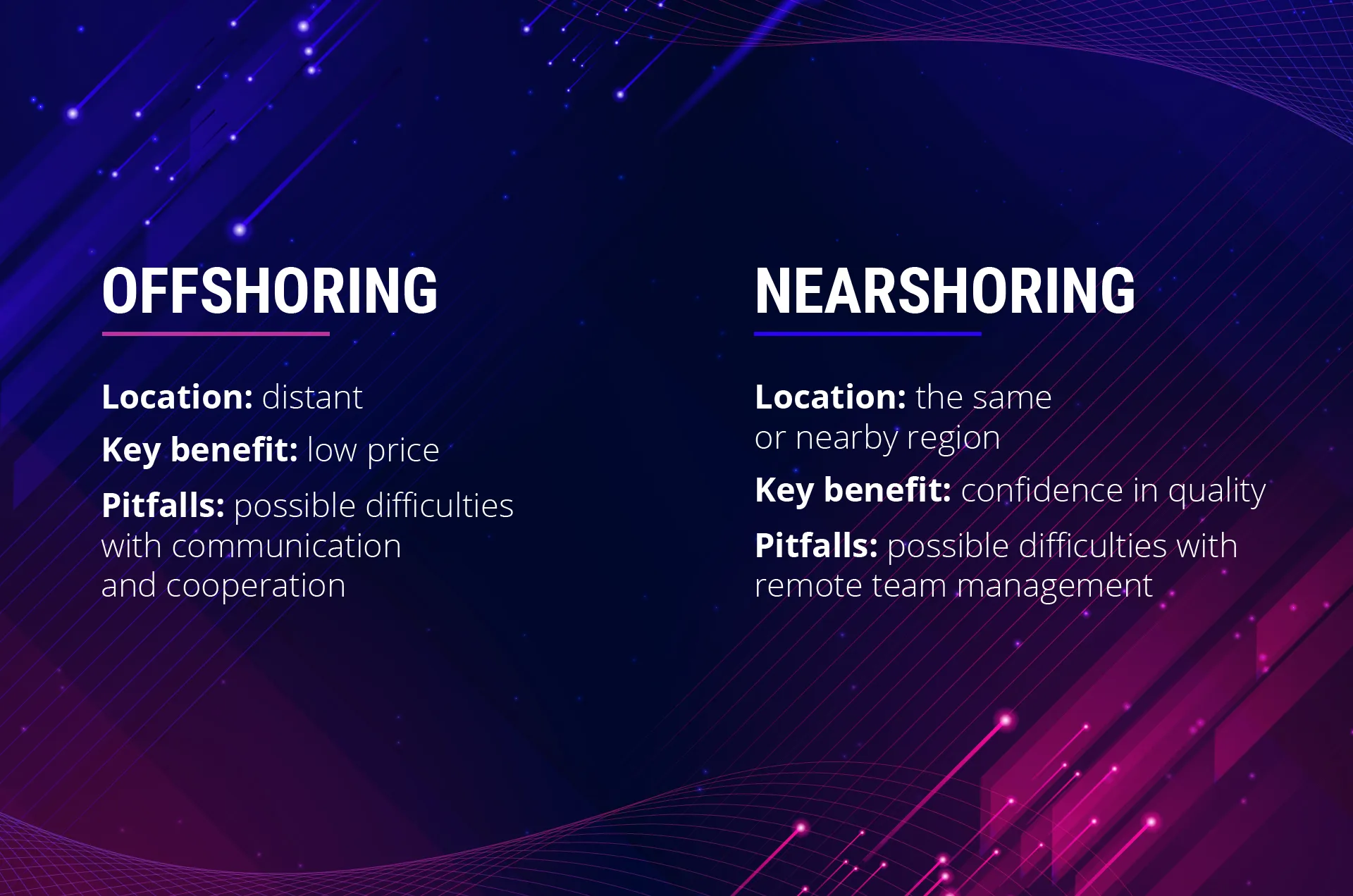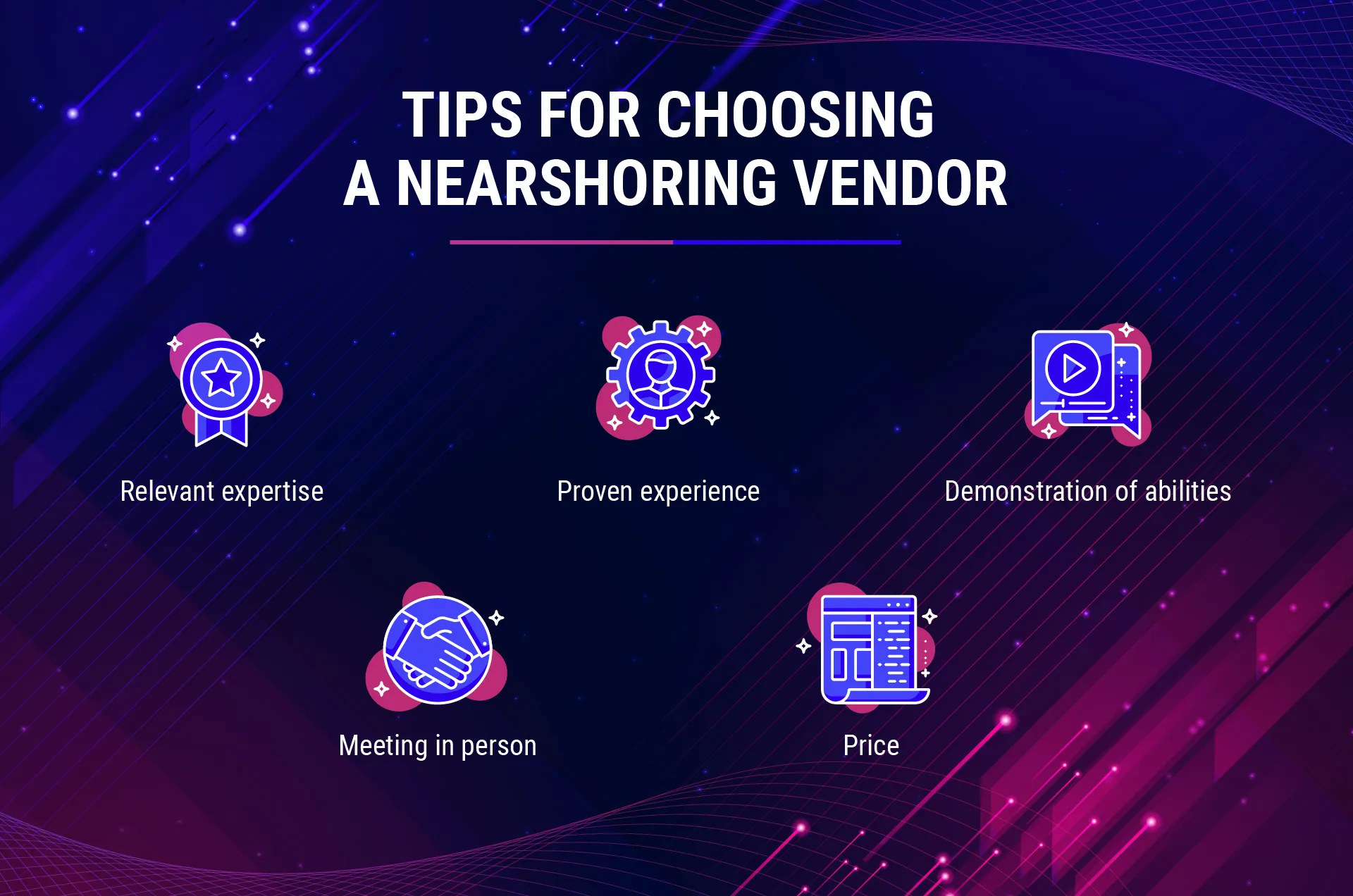The Secret of Successful Nearshoring
Table of contents
- Nearshoring vs Offshoring: Defining Two Models
- Offshoring
- Nearshoring
- Why choose nearshoring? Disclosing the key benefits
- Reasonable price of development
- More confidence
- More convenience
- Reduced travel expenses
- Nearshoring pitfalls and how we address them at Emerline
- Relations-building issues
- Lack of visibility into the development process
- Post-release issues
- Tips for choosing a nearshoring vendor
- Relevant expertise
- Proven experience
- Demonstration of abilities
- Meeting in person
- Price
- Concluding: how to get the most out of nearshoring?
- Plan your project in detail
- Build a nearshore team
- Communicate with your vendor
- Discover what your end users want
In the modern world, software development outsourcing has become a common practice for different companies, including startups that don't have internal IT teams and large companies where IT specialists have too many things on their plates. In both cases, business owners are pushed to search for a vendor capable of creating a required solution at a reasonable price.
Generally, there are two models of outsourcing to consider: nearshoring and offshoring.
In this post, we are going to highlight the difference between the existing models and focus on nearshoring, disclosing its key benefits and pitfalls, the ways to address the latter, provide tips on how to choose a vendor and effectively organize the process of development. So why beat around the bush? Let's start.
Nearshoring vs Offshoring: Defining Two Models
Even though the main difference between these two models is quite obvious, as it is included in their names, let's define each to get a better understanding of what's what.

Offshoring
The offshoring model implies that the development process will be relocated to distant locations, such as India, China, and the Philippines are for Western companies.
When considering the offshoring model, it is important to take into account such aspects as the difference in time zones, cultures, languages, etc., which can have a strong impact on the success of product development.
When talking about the benefits of offshoring, the main one comes with a lower price on development. Nevertheless, it depends on the region and the size of a chosen company. So sometimes, there are cases when software outsourcing to a large and experienced company in India can be more expensive than the development of the same solution in a smaller company within the customer's region.
Nearshoring
Just what it sounds like, the nearshoring model means that a company transfers the development to a vendor located in the same region. For example, it outsources product development from Poland to Belarus or from Austria to Romania.
Nearshoring has a lot of benefits on offer, starting from slight time-zone differences and fewer cultural discrepancies to more cost-effective solutions and, quite often, the same data protection laws and similar financial and legal constraints.
When comparing the price of offshoring to nearshoring, in most cases, the latter is a more expensive option. Nevertheless, it depends. Furthermore, in this case, the higher price is justified by fewer risks and more convenience.
Why choose nearshoring? Disclosing the key benefits
Now, let's dive deeper into the advantages of nearshoring, so you can get a clearer image of what it has on offer.
Reasonable price of development

When compared to price estimates in a customer's country, the nearshoring model is often far less expensive.
More confidence
Choosing a nearshoring model means you will have fewer worries about the quality of work because generally, it doesn’t differ much in the same regions, only the price can vary.
More convenience
It will be easier for you to communicate with your vendor's representatives because the 1-2 hour difference in time zones is not a problem. Furthermore, there would probably be no cultural barriers.
Reduced travel expenses

Nearshoring allows you to avoid expensive flights. Furthermore, it also saves your time on business traveling.
To sum up, we can say that in the battle nearshoring vs offshoring, the first model wins, becoming a greater solution in terms of convenience, confidence, and minimized travel expenses.
Nearshoring pitfalls and how we address them at Emerline
But it would be unfair to say that the model completely frees you from all worries associated with outsourced software development. For sure, it has some disadvantages that we are going to disclose below. Just note that it’s possible to eliminate them, and to prove this, we’ll tell you how we do it at Emerline.
Relations-building issues
Because you don't see your remote team each day/week/month, there is a great chance of separation that stands for "us" and "them". In other words, a lack of communication becomes a barrier to building reliable relations with your vendor and takes you away from the benefits of having a remote team.
At Emerline, we always make sure that our clients can contact us at any time to discuss the details of the project and see how we instantly solve any questions that arise.
Lack of visibility into the development process
Working with a remote team differs from the in-house organization of the development process, and sometimes it is possible to lose track of what happens with your product.
"Where are we and what is the stage of development?"
There are also cases when you want to make some changes, and if there is no visibility into what's happening, you can find yourself in a situation when you need to pay twice because the very first version of what you initially requested has been already developed.

It is impossible to read people's minds, but it is possible to know what your remote team does. The remote delivery process established at Emerline includes daily reporting, so our clients are always aware of the development process and can easily make adjustments when needed.
Post-release issues
When considering an outsourcing model, one of the greatest concerns companies face is related to post-release times, when the total scope of work is paid and it seems like there's no one left to rely on and ask for fixes.
At Emerline, we always make sure that our clients are completely satisfied with the delivered products. So it's a common practice for us to contact them after a while and ask if everything goes as planned and whether we can do something to better their experience of using the software we delivered.
Tips for choosing a nearshoring vendor

In addition to the above-written, it is worthy of saying that nearshoring experience, whether positive or negative, depends on a company you choose as your software development provider. And considering the fact that companies are not created equal, it is highly important to pay attention to the following:
Relevant expertise
You don't expect that a dentist will perform bright with heart surgery. So make sure that your vendor has expertise relevant to your requirements.
Proven experience
It will be easier for you to understand whether an outsourcing software development company you are contacting will be capable of satisfying your project needs if you ask to show relevant cases.
Demonstration of abilities
You can ask your vendor to show you the process of development, technological competencies, and lessons learned from similar projects.
Meeting in person
While a request for a proposal (RFP) and request for information (RFI) can provide you with a clearer picture of what to expect, meeting in person is always a better option.
Price
For sure, if you can save on the development, do it. Just note that the quality of the product you will receive is of higher importance than insignificant savings.
Concluding: how to get the most out of nearshoring?
Although nearshoring often becomes a more preferable option to offshoring, it is not an outsourcing panacea. Along with the benefits on offer, it also has some disadvantages. And it’s not just up to your vendor to address them. To conclude, we would like to provide you with some tips on how you can organize the process to get the best of this model.
Plan your project in detail

The more confident you are with what you want to have as the result of outsourced software development, the more chances you will get it. It will be easier for your vendor to navigate in your requirements and make your ideas come true if you provide them with a clear picture of the desired solution. Ask yourself, why you need this product, what functionality you expect from it, how it should look like, and what outcomes it should bring.
Build a nearshore team
Think of how many people you would like to hire, what their must-have skills are, and how many hours per day they need to devote to your project development. Furthermore, consider hiring a project manager who will coordinate developers and serve as a communication bridge between your company and the remote team, making a process of development more efficient.
Communicate with your vendor
The importance of communication is often underestimated. But the truth is that the outcome of a well-established communication is better, faster, and smarter results. Don't hesitate to ask your vendor all necessary questions, share your vision, and discuss every detail that can affect the quality of the product under development.
Discover what your end users want
It’s no secret that the success of the software developed depends heavily on whether it fits end users’ needs and expectations. So if you want to create a valuable product that solves specific business issues, make sure that the opinion of end users is considered: don’t hesitate to involve them in development and better do it as early as it is possible. Being adopters of the Design Thinking methodology, we highly recommend not to avoid this step if you are on the way to creating a product that would really matter.
It’s not that difficult, right? And when combined with a smartly chosen contractor and the possible pitfalls in mind, such an approach can work miracles for your project.
Now you know the little secrets of successful nearshoring, and we do hope that this knowledge will contribute to the outstanding experience. By the way, always feel free to contact us to discuss your project’s requirements and expectations. We are here to make your technological dreams come true.
Published on Jul 17, 2020





